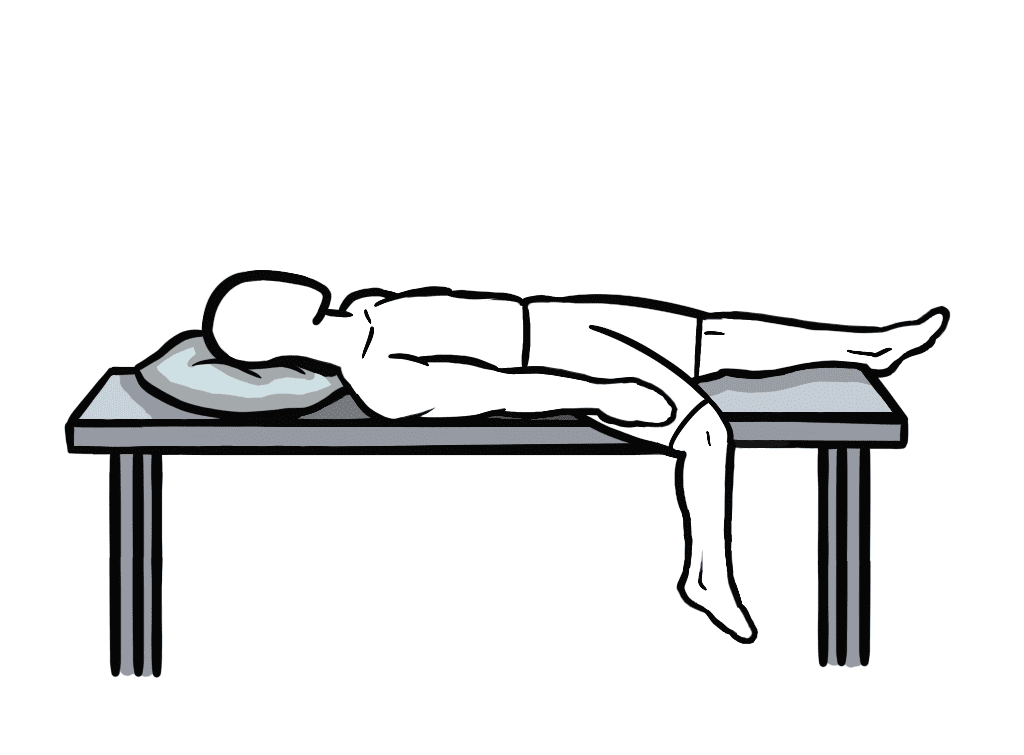Hip flexors are a group of muscles that play an essential role in the movement of the lower body. They are located in the hip area and are responsible for flexing the hip joint and lifting the leg towards the body. However, many people are unaware of the impact that hip flexor health can have on their night’s rest.
When hip flexors are tight or strained, they can cause discomfort and pain in the hip area, which can make it difficult to sleep comfortably. Additionally, tight hip flexors can cause imbalances in the body, leading to poor posture and alignment, which can further contribute to sleep disturbances. Understanding the importance of hip flexor health can help individuals take steps to improve their sleep quality and overall well-being.
Understanding Hip Flexor Health

Hip flexors are a group of muscles that play a vital role in maintaining the health of the hips and lower body. These muscles connect the hips to the legs and are responsible for movements such as walking, running, and jumping. The hip flexor muscles include the iliacus and psoas muscles, which together form the iliopsoas muscle.
The hip joint forms a ball-and-socket connection between the femur (thigh bone) and the pelvis. The hip flexor muscles originate from the lumbar spine and pelvis and attach to the femur. These muscles work together to flex the hip joint, allowing you to lift your leg towards your body.
The psoas muscle is the primary hip flexor muscle and is responsible for lifting the thigh towards the torso. The iliacus muscle, on the other hand, is responsible for stabilizing the hip joint during movement. Together, these muscles play a crucial role in maintaining good posture, balance, and stability.
Anatomy-wise, the psoas muscle originates from the lumbar spine and runs down to the hip joint, where it attaches to the femur. The iliacus muscle originates from the iliac crest (part of the pelvis) and attaches to the femur. These muscles work together to form the iliopsoas muscle, which is responsible for hip flexion.
Causes of Hip Pain
Hip pain is a common complaint that can be caused by a variety of factors. Understanding the underlying causes of hip pain can help individuals take appropriate measures to alleviate their discomfort and maintain good hip flexor health.
Overuse and Injury
Overuse and injury are two of the most common causes of hip pain. Athletes and individuals who engage in physical activities that involve repetitive motions, such as running or cycling, are at an increased risk of developing hip pain due to overuse. Injuries, such as strains, sprains, and fractures, can also cause hip pain. These injuries can occur due to falls, accidents, or sudden movements.
Arthritis and Bursitis
Arthritis and bursitis are two conditions that can cause hip pain. Arthritis is a condition that causes inflammation in the joints, leading to pain and stiffness. Osteoarthritis is the most common form of arthritis that affects the hip joint. Bursitis is the inflammation of the bursae, which are small sacs of fluid that cushion the joints. Bursitis can occur due to overuse, injury, or infection.
Tendonitis and Sciatica
Tendonitis and sciatica are two other conditions that can cause hip pain. Tendonitis is the inflammation of the tendons that connect the muscles to the bones. It may arise from overuse, injury, or the natural aging process. Sciatica manifests when the sciatic nerve, extending from the lower back down to the legs, experiences compression or irritation. This can cause pain, numbness, and tingling in the hip, buttocks, and legs.
How Hip Pain Affects Night’s Rest
Hip pain can significantly impact a person’s ability to get a good night’s rest. People who experience hip pain at night may find it difficult to fall asleep, stay asleep, or get comfortable in bed. This can lead to sleep disruptions, fatigue, and other negative health consequences.
Sleeping Position and Hip Pain
Sleeping position can play a significant role in hip pain at night. Side sleepers, in particular, may be more prone to hip pain due to the pressure that is placed on the hips when sleeping on one side for an extended period. This pressure can cause inflammation and pain in the hip joint, which can make it difficult to sleep comfortably.
To alleviate hip pain while sleeping, individuals may need to adjust their sleep posture. For example, sleeping with a pillow between the knees can help to reduce pressure on the hips and promote better alignment of the spine. Alternatively, sleeping on the back with a pillow under the knees can also help to alleviate hip pain.
Hip Pain and Sleep Disruptions
Hip pain can also lead to sleep disruptions, which can further exacerbate the problem. When individuals experience pain or discomfort in their hips, they may be more likely to wake up frequently throughout the night. This can lead to poor sleep quality and daytime fatigue.
To improve sleep hygiene and reduce the impact of hip pain on sleep, individuals may need to make lifestyle changes. This may include incorporating more physical activity into their daily routine, practicing good sleep hygiene, and using pain management techniques to reduce inflammation and discomfort in the hip joint.
Overall, sleep postures for hip flexor can play a significant role in a person’s ability to get a good night’s rest. By making adjustments to sleep posture and practicing good sleep hygiene, individuals can reduce the impact of hip pain on their sleep and improve their overall health and wellbeing.
Managing Hip Pain for Better Sleep
Hip pain can cause discomfort and disrupt sleep. Individuals who experience hip pain can take steps to manage their pain and improve their sleep quality. Here are some tips for managing hip pain for better sleep:
Choosing the Right Mattress
Choosing the right mattress can help alleviate hip pain and improve sleep quality. A mattress that is too firm can put pressure on the hips and cause pain. On the other hand, a mattress that is too soft can cause the hips to sink, leading to misalignment of the spine.
For individuals with hip pain, a medium-firm mattress is recommended. This type of mattress provides enough support to keep the spine aligned while also cushioning the hips. A mattress with memory foam or latex can also help distribute body weight evenly, reducing pressure on the hips.
Effective Sleeping Positions
Sleeping positions can also affect hip pain. Sleeping on the back with a pillow under the knees can help align the spine and reduce pressure on the hips. Side sleeping is also a good option, but individuals should avoid sleeping on the side with the affected hip. Placing a pillow between the legs can also help align the hips and reduce pressure.
Individuals who prefer to sleep on their stomach should place a pillow under the hips to reduce pressure. However, sleeping on the stomach is not recommended for individuals with hip pain as it can cause the spine to arch and increase pressure on the hips.
Use of Pillows and Support
Using pillows and support can help alleviate hip pain and improve sleep quality. A pregnancy pillow can provide support and cushioning for the hips, reducing pressure and discomfort. A body pillow can also be used to support the hips and keep the spine aligned.
Individuals with hip pain can also use a wedge pillow to elevate the hips slightly. This can help reduce pressure on the hips and improve blood flow. A rolled-up towel or blanket can also be placed under the hips for additional support.
Exercises and Stretches for Hip Flexor Health

Maintaining healthy hip flexors is crucial for a good night’s rest. Here are some exercises and stretches that can help improve hip flexor health.
Yoga and Tai Chi
Yoga and Tai Chi are low-impact exercises that can help improve hip flexor health. These exercises focus on stretching and strengthening the muscles, which can help improve mobility and range of motion. Some yoga poses that can be particularly beneficial for hip flexors include the low lunge, pigeon pose, and warrior II pose. Tai Chi exercises, such as the horse stance, can also help improve hip flexor health.
Low-Impact Exercises
Low-impact exercises such as cycling, swimming, and walking can help improve hip flexor health. These exercises are easy on the joints and can help improve muscle strength and flexibility. Cycling and swimming are particularly beneficial as they involve continuous movement, which can help improve hip flexor health.
Stretching and Mobility Work
Stretching and mobility work can help improve hip flexor health by increasing flexibility and range of motion. Some stretches that can be particularly beneficial for hip flexors include the butterfly stretch, the kneeling hip flexor stretch, and the standing quad stretch. Mobility work, such as foam rolling and dynamic stretching, can also help improve hip flexor health.
Incorporating these exercises and stretches into your daily routine can help improve hip flexor health and promote a good night’s rest. Remember to consult with a healthcare professional before starting any new exercise routine.
Medical Intervention and Treatment
Hip flexor pain can be debilitating and significantly impact one’s quality of life. Medical intervention and treatment can help alleviate symptoms and promote healing. The following are some common medical interventions for hip flexor pain.
Physical Therapy
Physical therapy is a common treatment option for hip flexor pain. A physical therapist can work with the patient to develop a personalized exercise plan that can help stretch and strengthen the hip flexor muscles. Physical therapy can also help improve range of motion and reduce pain.
Medication and Pain Management
In some cases, medication may be prescribed to help manage pain associated with hip flexor injuries. Over-the-counter pain relievers such as ibuprofen and other nonsteroidal anti-inflammatory drugs (NSAIDs) can help reduce inflammation and pain. In more severe cases, prescription pain medication may be necessary.
Diagnosis and Treatment Plan
Proper diagnosis is critical in determining the most effective treatment plan for hip flexor pain. A medical professional will typically start with a physical exam and may order imaging tests such as X-rays or MRI scans to determine the extent of the injury. Once a diagnosis has been made, a treatment plan can be developed that may include physical therapy, medication, and rest.
Conclusion
Hip flexor health is an important factor that impacts the quality of sleep one gets at night. Poor hip flexor health can cause discomfort, pain, and other symptoms that can disrupt sleep.
Overall, maintaining good hip flexor health is an important aspect of overall health and wellbeing. By taking steps to manage and support hip flexor health, individuals can improve their sleep quality and overall quality of life.



